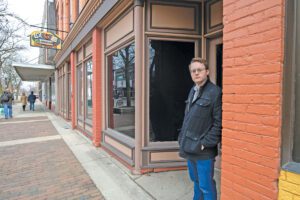Browsing through the local interest section of the Ann Arbor District Library, videographer and true-crime enthusiast Andrew Templeton came across Edward Keyes’ 1976 book The Michigan Murders. Republished in 2010 by the U-M Press, the book recounts a series of killings in the Ann Arbor area in the late 1960s. A fan of Sixties culture and music, Templeton was fascinated to learn that a local true-crime story took place during that time period.
“I assumed someone had already made a documentary about this,” he says, but, apart from a couple of TV specials, nothing had been done. Six years later, Templeton is in the final stretch of his self-produced feature-length documentary 1969: Killers, Freaks, and Radicals.
A native of the Detroit suburbs, Templeton, thirty-three, came to Ann Arbor to work as a videographer for Hagerty, the Traverse City–based specialty auto insurance and auto enthusiast company. He is now self-employed, and the film is his primary focus. Much of the film is self-financed, with Templeton doing most of the work himself and calling in favors from friends in the industry. He’s hoping favorable responses from festival audiences may lead to a distribution deal.

Videographer and true-crime enthusiast Andrew Templeton was fascinated when he came across Edward Keyes’s 1976 book The Michigan Murders at the Ann Arbor library. Now he’s wrapping up work on his own self-produced documentary 1969: Killers, Freaks, and Radicals.
Templeton believes the Michigan Murders story “is much more complex than it appears on its face.” Set in a backdrop of hippie culture, political unrest, and “the massive societal issues at play at the time,” he imagines that living through that period of Ann Arbor’s history “must have been very strange.” Between 1967 and 1969, seven young women and girls between the ages of thirteen and twenty-three were brutally murdered in the Ann Arbor and Ypsilanti area. An eighth murder, in Salinas, California, fit the same pattern.
Only the murder of Karen Sue Beineman, an eighteen-year-old EMU student from Grand Rapids, was formally solved: in 1970, EMU student John Norman Collins was convicted of the crime. In the first-ever case where neutron activation analysis was used to solve a murder, hairs found on Beineman’s body were linked to him based on the elements they contained. It would be many more years before an individual’s DNA could be used to solve crimes. Investigators have since tried to link Collins’ DNA to evidence from the other murders and found one match.
Collins—who in prison changed his last name to Chapman—never confessed. But the murders stopped after his arrest.
Collins’ family, friends, and the Catholic nuns who taught him in Center Line north of Detroit would never believe that the clean-cut, handsome captain of the football team was capable of being one of the first known serial killers. In fact, the term “serial killer” had not yet been coined. There have been a number of films and television series that romanticize serial killers as “charming anti-heroes,” says Templeton, but he is less focused on Collins than on capturing “the vibe of the time.”
He is troubled by his feeling that, had the women’s movement been further along, the murders may not have taken place. Evidence suggests that Collins’ victims went with him willingly—Templeton even interviewed a woman who suspected Collins of the murders but still got on a motorcycle with him. “She said it had something to do with the way she was raised,” he explains. “It was an expectation for her to go along with what a forceful man wanted.”
Though the U-M had admitted women for a century by then, it still was considered to be “in loco parentis” for female students—acting “in place of the parents for young women because they weren’t considered to have agency,” Templeton says. Had women felt more empowered to trust their own judgment, he believes they may have refused to go with Collins.
Templeton hopes to wrap up post-production this summer and submit the film to festivals, but he is still doing interviews.
“We’re still looking to hear from young women at the time, their stories,” he says. “Not about the murders in particular, but what it was like to be a woman back then.” He can be reached at facebook.com/1969documentary.

